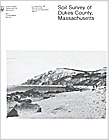The following map unit description is from the published "Soil Survey of Dukes County, Massachusetts"

Soil Survey of
Dukes County Massachusetts
The following map unit description is from the published "Soil
Survey of Dukes County, Massachusetts"

TaA- Tisbury very fine sandy loam, 0 to 3 percent slopes. This soil is very deep, nearly level, and moderately well drained. It is in depressions and low areas adjacent to open water in the central and southern parts of Martha's Vineyard. The areas of this soil are irregular in shape and range from 4 to 50 acres. They make up less than 1 percent of the survey area.
Typically, the surface layer is very dark grayish brown very fine sandy loam 1 inch thick. The subsoil is dark yellowish brown, yellowish brown, and light yellowish brown very fine sandy loam 29 inches thick and is mottled in the lower part. The substratum is brownish yellow, mottled sand to a depth of 60 inches or more.
Included with this soil in mapping are small areas of Haven, Klej, Pompton, and Riverhead soils. Included areas make up about 20 percent of this unit.
The permeability of this Tisbury soil is moderate in the subsoil and rapid or very rapid in the substratum. Available water capacity is high. This soil has a seasonal high water table at a depth of 1.5 to 3 feet in late fall, in winter, and in spring.
Most areas of this soil are in woodland. Many areas are in grassland, and a few are in cropland.
This soil is well suited to cultivated crops and to hay and pasture. Good tilth is easily maintained, but the seasonal high water table commonly keeps the soil wet in early spring and delays cultivation. Drainage is commonly needed in areas used for crops but is generally not needed for hay or pasture. Mixing crop residue and manure into the surface layer helps to maintain tilth and increase the organic matter content of the soil. The use of proper stocking rates and deferred and rotational grazing help to maintain desirable pasture plant species.
This soil is well suited to woodland productivity. Removal or control of competing vegetation will help the survival rate of seedlings. The common trees on this soil are white oak, eastern white pine, scarlet oak, black oak, and red pine.
The seasonal high water table limits this soil as a site for dwellings with or without basements and as a site for septic tank absorption fields. The permeability in the substratum of some areas prevents adequate filtering of septic tank effluent, causing a hazard of ground water pollution. Regional drainage or fill helps to overcome the water table. Low density housing reduces the volume of effluent, thus lessening the pollution hazard.
This soil is in capability subclass IIw.